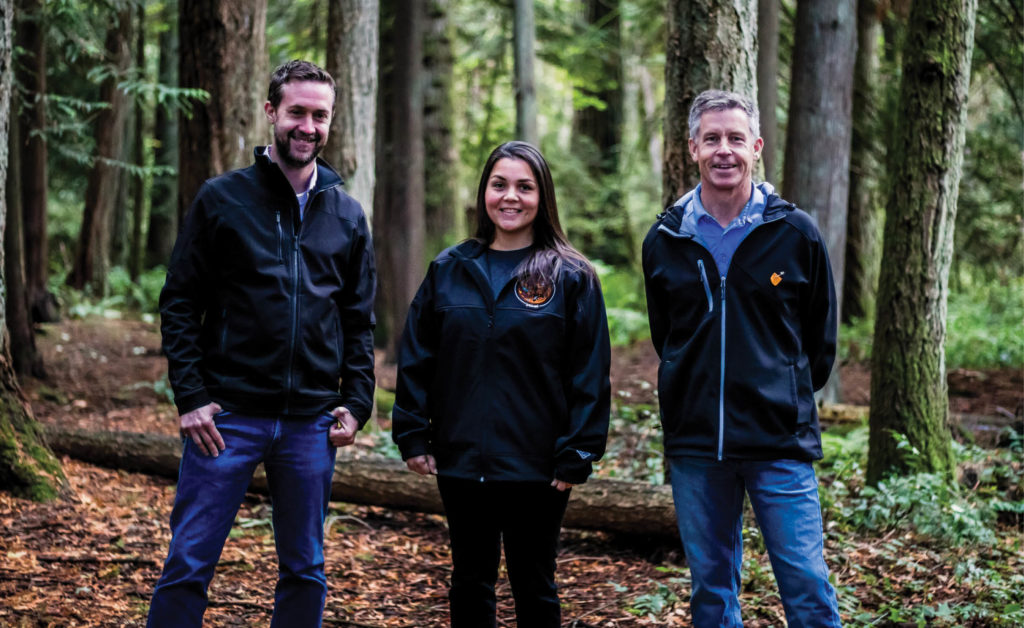by Jo Barnes | photo by Amanda Cribdon Photography
L to R: Ryan Windsor, Joni Olsen and Geoff Orr
In a conversation, there is a world of difference between hearing someone and actually listening.
While the relationship between local municipal governments, First Nations councils and communities are always developing, the efforts to communicate and the projects which are launched are most successful when dialogue is respectful, and time is taken to fully understand all perspectives.
“Trust is built over time,” says Joni Olsen, Tsartlip First Nations Councillor and Policy Negotiations Analyst with the W̱SÁNEĆ Leadership Council (WLC).
“It’s so important to have sincere and authentic dialogue,” notes North Saanich Mayor Geoff Orr.
Central Saanich Mayor Ryan Windsor concurs: “It is important to listen. We are building trust and respect.”
Community connections on the Peninsula grow out of geographic location, economic relationships and historical agreements. Tsartlip and Tsawout First Nations are part of the Central Saanich municipality and residents have full voting rights. Even though Pauquachin and Tseycum First Nations do not get a municipal vote, this does not prevent them from building a relationship with the municipalities.
Most people understand that municipal governance comes about through an election process. Community residents vote for a mayor and council members. First Nations communities also have elected representatives, but elders within these communities have significant influence on decisions.
It is easy to look at communities merely through the lens of geographic location and governance. However, at their core, communities are people. This effort to understand the people which make up a community is where the work begins.
“It’s about entity versus people. Take the time to understand and engage on the human individual level,” comments Mayor Orr.
While the current climate of reconciliation prompts parties to engage, racist reactions may challenge any progress.
“There is a large movement right now for reconciliation,” says Joni. “This encourages municipalities to step up to the plate. Citizen racism slows forward movement, and racist acts are still experienced by community members daily.”
Municipal councils have standing protocols to acknowledge the traditional territories upon which they work. However, according to Joni, that is only the beginning as there is a lack of understanding and ignorance that is based in fear that still exists.
“It is about overcoming misconceptions about our community history and the stereotypes,” says Joni. “Often, the fear is not logical.”
Whether it’s a municipality or First Nation community, each has its challenges. In the words of Mayor Orr, all must ask the question: “How do we advance our community?”
One step toward advancing all local First Nations was establishing the W̱SÁNEĆ Leadership Council. This organization serves as a unified body that represents and coordinates efforts of the Tsartlip, Tseycum and Tsawout First Nations in their interactions with each other and with various levels of government.
“We advocate and create relationships with local councils,” shares Joni.
Since forming, the council has completed significant initiatives. A Letter of Understanding was drawn up between the Federal Government and W̱SÁNEĆ and committed both parties to move forward together towards lasting reconciliation and to work together to make progress on issues important to the W̱SÁNEĆ Nations.
At its heart, the purpose of dialogue is to foster understanding. It helps to learn another’s language, even in basic terms.
“We are trying to understand the pronunciation of SENĆOŦEN (sin-chaw-thin),” says Mayor Windsor. “It’s a small step but huge in terms of understanding.”
Conversations can lead to collaboration. Projects such as the new stormwater system and crosswalk on Stelly’s Cross Road are examples of successful collaboration and consultation.
“Community forums were held. Tsartlip First Nation, the Federal Government and Central Saanich council worked together. It was successful in terms of safety issues for the community,” says Mayor Windsor.
A positive relationship between municipal and First Nations councils hinges on opportunities for all parties to sit at the table together. Sometimes this may involve a third party like MODUS, a communications and engagement consulting group.
“Currently municipalities are working on new Community Plans and servicing agreements,” comments Joni. “The WLC has worked with MODUS which is coordinating the review and update of local municipal policy, which will amongst other things, better reflect local indigenous values in their policies.”
Effective communication between local governments and First Nations can lead to collaboration and positive change. All parties agree that dialogue must be open, sincere, respectful, and embrace all perspectives.
“To do this work you have to open yourself up and put away preconceived notions,” shares Mayor Orr.
It’s about ensuring there is an opportunity for everyone to have a voice, be willing to make mistakes, be authentic, and learn from one another.




